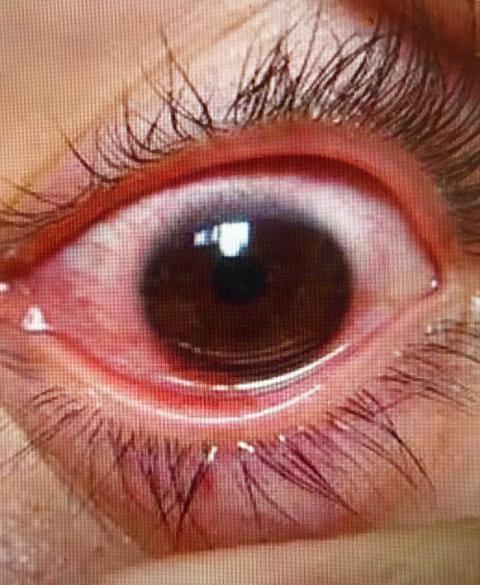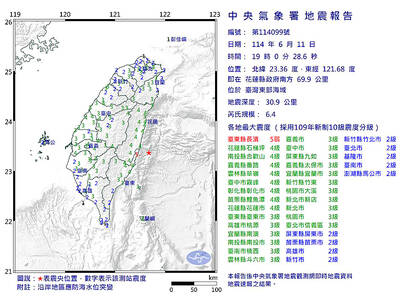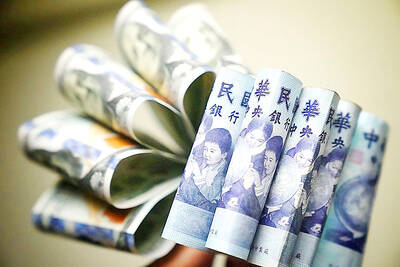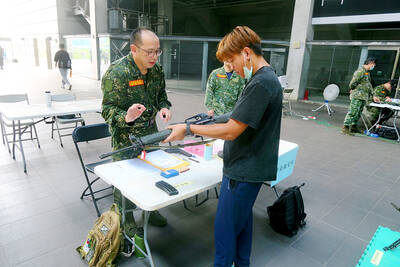An ophthalmologist on Monday warned people against using their smartphones for extended periods with screen brightness set to the highest level after a woman developed red eyes and experienced symptoms of corneal abrasion.
The 25-year-old woman, surnamed Chen (陳), in September last year sought medical help for red, teary eyes, as well as eye pain and floaters, said Hung Chi-ting (洪啟庭), an ophthalmologist at Fooyin University Hospital in Pingtung County.
An eye exam showed that her best corrected visual acuity was 0.5 and 0.6, he said.

Photo copied by Hung Chen-hung, Taipei Times
Chen said that her work as a secretary requires her to stay in touch with clients outside the office, and to see her smartphone’s screen clearly, she usually adjusted screen brightness to the highest level, or 625 lux, Hung said.
While this enabled her to see the messages on her smartphone in daylight, the combination of blue light emitted by the device and ultraviolet light from the sun bouncing off the screen increases the risk of developing cataracts and retinopathy, and could also lead to pink eye or corneal abrasion, he said.
Chen also did not lower the screen brightness after work and watched online shows on her smartphone with the lights turned off, he said.
Over time, this could result in severe inflammation of the cornea, conjunctivitis and floaters, Hung added.
Chen’s symptoms were relieved after three to four days of treatment using topical antibiotics and steroids, as well as artificial tears and other eye drops and creams, the ophthalmologist said.
To prevent similar cases, smartphone users should not keep screen brightness at the highest level all day, look at their smartphone’s screen under sunlight or view the screen in complete darkness, Hung said.
Computer and smartphone screens should be viewed from a distance of 30cm to 40cm, and the level of brightness should not exceed 500 lux, he said.

A magnitude 6.4 earthquake struck off the coast of Hualien County in eastern Taiwan at 7pm yesterday, the Central Weather Administration (CWA) said. The epicenter of the temblor was at sea, about 69.9km south of Hualien County Hall, at a depth of 30.9km, it said. There were no immediate reports of damage resulting from the quake. The earthquake’s intensity, which gauges the actual effect of a temblor, was highest in Taitung County’s Changbin Township (長濱), where it measured 5 on Taiwan’s seven-tier intensity scale. The quake also measured an intensity of 4 in Hualien, Nantou, Chiayi, Yunlin, Changhua and Miaoli counties, as well as

Credit departments of farmers’ and fishers’ associations blocked a total of more than NT$180 million (US$6.01 million) from being lost to scams last year, National Police Agency (NPA) data showed. The Agricultural Finance Agency (AFA) said last week that staff of farmers’ and fishers’ associations’ credit departments are required to implement fraud prevention measures when they serve clients at the counter. They would ask clients about personal financial management activities whenever they suspect there might be a fraud situation, and would immediately report the incident to local authorities, which would send police officers to the site to help, it said. NPA data showed

ENERGY RESILIENCE: Although Alaska is open for investments, Taiwan is sourcing its gas from the Middle East, and the sea routes carry risks, Ho Cheng-hui said US government officials’ high-profile reception of a Taiwanese representative at the Alaska Sustainable Energy Conference indicated the emergence of an Indo-Pacific energy resilience alliance, an academic said. Presidential Office Secretary-General Pan Men-an (潘孟安) attended the conference in Alaska on Thursday last week at the invitation of the US government. Pan visited oil and gas facilities with senior US officials, including US Secretary of the Interior Doug Burgum, US Secretary of Energy Chris Wright, Alaska Governor Mike Dunleavy and US Senator Daniel Sullivan. Pan attending the conference on behalf of President William Lai (賴清德) shows a significant elevation in diplomatic representation,

The Taipei City Reserve Command yesterday initiated its first-ever 14-day recall of some of the city’s civilian service reservists, who are to undergo additional training on top of refresher courses. The command said that it rented sites in Neihu District (內湖), including the Taipei Tennis Center, for the duration of the camp to optimize tactical positioning and accommodate the size of the battalion of reservists. A battalion is made up of four companies of more than 200 reservists each, it said. Aside from shooting drills at a range in New Taipei City’s Linkou District (林口), the remainder of the training would be at